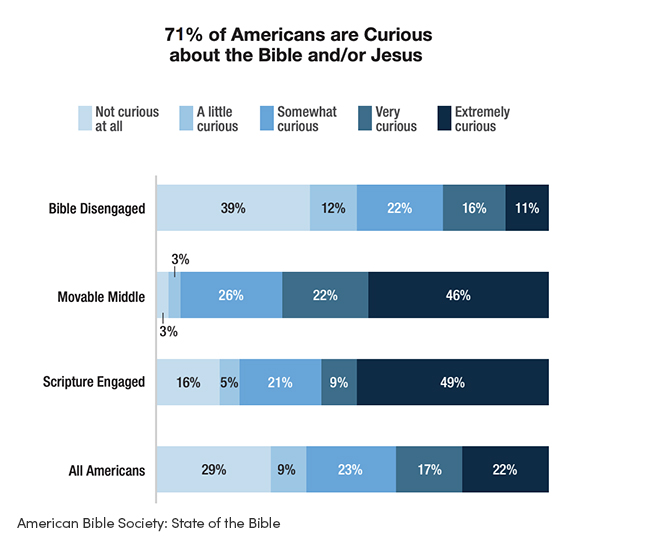
U.S. adults who are engaged with Scripture are becoming increasingly rare but are also uncommonly hopeful.
By Aaron Earls
Fewer American adults qualify as Bible users, according to the latest State of the Bible study. Those who are engaged with Scripture, however, have higher levels of hope than other adults in the United States.
In January 2023, around 100 million adults, or 39% of Americans, said they use the Bible three or more times a year. That equals the lowest number in the 13-year history of the study and ties with last year as the lowest percentage. In 2021, at the height of the pandemic, 128 million Americans (50%) said they interacted with Scripture at least that much.

Despite the decline in Bible users, 63 million Americans (24%) personally engage with Scripture at least weekly, beyond church services.
Certain demographic groups are more likely than others to connect with the Bible at least a couple of times a year:
- Women (41%) compared to men (36%)
- Those separated from their spouse (52%) compared to those never married (30%)
- Black Americans (57%) compared to Hispanics (40%), whites (35%) and Asians (27%)
- Evangelical Protestants (70%) and historically Black Protestants (68%) compared to mainline Protestants (46%) and Catholics (37%)
Generationally, elders (48%) and boomers (46%) are more likely than Gen Xers (38%), millennials (33%), and members of Gen Z (30%) to use the Bible at least occasionally during the year.
As to why so few people are using Scripture, most point to a lack of time, understanding, or excitement. Given six options and asked to choose their top two frustrations with Bible reading, Americans say they don’t have enough time (26%), don’t know where to start (17%), lack excitement about reading it (16%), have difficulty relating to language (15%), see the layout as difficult to navigate (9%), or feel the stories are confusing (8%).
Bible engagement and curiosity
Those who qualify as Scripture engaged by having higher levels of Bible reading and application have steadily declined over the past four years. The number of Scripture engaged fell from 71 million Americans in 2020 to 47 million today. Women (20%) are more likely than men (16%) to be Scripture engaged. Additionally, married people (23%) are more likely than those who never married (10%).
The 76 million in the “movable middle,” those with some but limited interaction with and application of the Bible, are up from 66 million in 2020 but down from 95 million in 2021. With 138 million Americans, the Bible disengaged are down from 145 million in 2022 but up from previous years.
Almost 3 in 4 Americans (71%) are at least a little curious about the Bible and/or Jesus, including 39% who are very or extremely curious. Click To TweetThe State of the Bible report from the American Bible Society also notes that “not only are there 10 million fewer Bible disengaged Americans than there were last year, they aren’t as disengaged as they used to be.” While they aren’t reading Scripture at a higher frequency, they are more likely this year than last to have higher scores in Bible impact and centrality. If that continues, the report says more may move into the middle category for 2024.
For many, that movement may be due to their curiosity about the Bible and/or Jesus. Almost 3 in 4 Americans (71%) are at least a little curious, including 39% who are very or extremely curious. That is driven primarily by those who are Scripture engaged (58%) and the movable middle (68%).

Even among those disengaged from the Bible, however, 61% express some level of curiosity about the Bible and/or Jesus, including more than 1 in 4 (27%) who say they are very or extremely curious. “Curiosity is a growth platform for Bible ministry in the U.S.,” according to the State of the Bible report.
Scriptural source of hope
Moving more people to become more engaged with Scripture may have other positive results. Bible-engaged Americans are more likely than any other group in America to have a hopeful perspective. Using questions related to the Persevering Hope Scale (PHS), a psychological assessment developed by scholars from five universities, the average score among Americans in the State of the Bible study is 3.8 out of 5.
Almost every demographic group remained within a tenth of that score. Women and men both had scores of 3.8. Generationally, boomers ticked up to 3.9 while elders slid to 3.7. Geographically, those in the Northeast were lowest at 3.7.
“Apparently, those who read the Bible regularly, who live and think according to its teaching, find resources that keep them going, even in tough times.” — @AmericanBible State of the Bible report Click To TweetThe report says there were “no great variances to report on except Scripture-engaged people, who outscored everyone else with a PHS of 4.1.” Those in the moveable middle had a score of 3.8, and the Bible disengaged averaged 3.7.

Noting the scores of the Scripture engaged, the report concludes, “No other demographic group scored that high. Apparently, those who read the Bible regularly, who live and think according to its teaching, find resources that keep them going, even in tough times.”
For permission to republish this article, contact Marissa Postell Sullivan.










